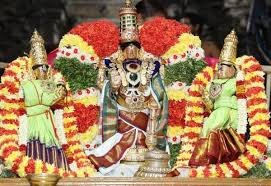Soundararajaperumal temple
Soundararajaperumal temple, Nagapattinam
The Soundararajaperumal Temple is a temple dedicated to the Hindu god, Vishnu. It is located in Nagapattinam, a town in the South Indian state of Tamil Nadu. Constructed in Dravidian style of architecture, the temple is glorified in the Nalayira Divya Prabandham, the early medieval Tamil canon of the Alvar saints from the 6th–9th centuries CE. It is counted as one among the 108 Divya Desams dedicated to Vishnu. Vishnu is worshiped as Soundararaja Perumal and his consort Lakshmi as Soundaravalli.
The temple is believed to have been built by the Medieval Cholas of the late 8th century CE, with later contributions at different times from Thanjavur Nayaks. The temple has two inscriptions dating from the Chola period. The temple has a five-tiered rajagopuram (gateway tower) within a granite wall. The complex contains all the shrines and water bodies associated with it.
Soundararaja Perumal is believed to have appeared for Sage Markandeya, Dhruva, Saleesan, and the goddess Bhudevi. The temple observes six daily rituals and three yearly festivals. The chariot festival, celebrated during the Tamil month of Chittirai (March–April), is the most prominent festival of the temple. The temple is maintained and administered by the Hindu Religious and Endowment Board of the Government of Tamil Nadu.
Legend
A distributary of the river Kaveri, Odambokki, passes close to the temple and the river is also called Virutha Kaveri. This leads to one of the names of presiding deity, “Kaveri Thuraivan”.
The present day Nagapattinam is believed to have been a forest, historically named Sundararinyam. During Treta Yuga a prince, Dhruva, heard about the importance of the forest and began a penance, wishing to see Vishnu. Pleased by this penance, Vishnu appeared to him. Following his example, Markendaya Maharishi did penance and attained the vision of Vishnu during Satya Yuga and Lakshmi, the consort of Vishnu, during Treta Yuga as did king Saleesa Chola during Kali Yuga. It is believed that two eunuchs, Kandan and Sukandan, attained physical fitness after having a holy dip in Sara Pushkarani, the temple tank. The Hindu god of creation, Brahma, started worshiping Vishnu at this place. Vishnu is believed to have appeared on the auspicious day of Masi Maham on the banks of Sarapushkarani. On account of the glow emanating from Masi Maham, Vishnu at this place was called “Aḻagiyan”. Since he had a glittering skin, he was called “Soundara Rajan”, meaning the most beautiful and his consort was called Soundaravalli. Since the king of Nagas (snakes), Adisesha worshipped Vishnu at this place, the place was called Nagar Pattinam, the place of Nagas.
History
The temple had contributions from Pallavas, Nagars, and Cholas during the 8th to 10th centuries. During the later centuries, Thanjavur Nayaks and subsequently the Thanjavur Marathas are believed to have made significant contributions to the temple. During the rule of the Nayaks, Nagapattinam was a busy port and it was more of a Dutch territory. On the request of the Dutch for a light house, the Nayak king is believed to have built the seven tiered temple tower and utilized it as the light house. Jagul Nayakar, the lieutenant of a Nayak king during the 1650s, was a staunch worshiper of Soundararaja Perumal. He is believed to have built the temple tower, halls and the compound wall around the temple. The image of him and his wife Lakshmi Ammal are installed in one of the halls built by them. Kundo Pandithar, an officer of the Nayak kingdom during 1737, is believed to have constructed the Ashtana mandapam, and the Pachai Varnar, Pavala Vannar, Veetriruntha Perumal, Kidantha Kola Perumal and Vishvaksenar shrines. During the early 20th century, Dratcha Balagurumuthi Chettiyar built the Bhakthiula hall, Chinnaya Chettiyar rebuilt the Vasantha hall, Nachiyappa Pillai rebuilt the Mataipalli, Ramasami Pillai renovated the image of the presiding shrine and the citizens of the town contributed to various other renovations. There are inscriptions from various ruling empires on the contributions made to the maintenance of the temple.





















